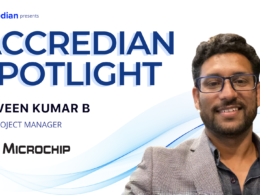Ambitious and driven, Chiranjeet Pathak not just wanted to know but learn about artificial intelligence technologies and data driven techniques whose implementation promises flexibility and ease of use. Believing that data science and data science projects hold the future, he enrolled for the Global Certificate in Data Science and AI (GCDAI) program at Accredian.
In this interview, let’s see what he has to say about the evolution and adoption of data science across industries and how his learning experience has been at Accredian.
Question 1: Which program & batch are you part of at Accredian & tell us more about your current work profile?
Chiranjit: I am in the Global Certificate in Data Science & AI (GCDAI) program which started on 14th June 2020. I am presently working in the process engineering and service team dealing with complex process design and commissioning. I oversee optimization of the process plant in the field of file center, make process Dominator analysis and troubleshoot to achieve the highest product quality.
Question 2: Walk us through your career journey & what got you interested in Data Science & Machine Learning?
Chiranjit: I have experienced significant shortcomings of today’s traditional concrete strategies due to complex processes’ highly nonlinear behavior. Today, artificial intelligence, data-driven techniques and data science projects are becoming useful due to simple implementation, easy design & flexibility. They are widely used in various applications like the modeling of process control, classification, detection, and IoT. These are the key interest areas, which intrigued me to dive into the field of DS.
Question 3: What all tools and packages in Data Science & Machine Learning have you mastered in your Data Science & AI program at Accredian so far?
Chiranjit: I believe I’m confident in the basic packages like NumPy and Pandas for logistic problems and data handling, profiling in detail for data processing, Matplotlib and Seaborn for data visualizations, and Escalon for building different ML models with spectral evolution techniques. I have also done case studies and data science projects on imbalanced binary classifications using fundamental Taylor sampling techniques.
Question 4: What were some of the initial challenges when you got started on your Data Science journey and how did you overcome it?
Chiranjit: Being a non-coder, I had to struggle a bit in the initial few weeks to understand the flow and syntax of codes in data science projects. It was also quite challenging to test very basic statistics concepts that I had studied 13 years back. I used to spend a minimum two to three hours regularly over Jupyter notebook for the initial four or five weeks to overcome it.
Question 5: Who is your favorite faculty at Accredian and what did you learn from him the Most?
Chiranjit: We had our faculty, Mr. Suchit Majumdar, for Term one and two, and Mr. Neelmani for term three. Both are equally good at their respective focus areas. But if I have to choose one, then I will opt for Mr. Suchit for the initial guidance and support that inspired and increased my interest in DS. He made me believe that even a non coder can take up data science as a career and it’s not that difficult.
Question 6: What is the goal of Data Science?
Chiranjit: One of the major goals of data science is conversion of a real business problem into a specific problem statement through proper understanding of the common knowledge.
Another one can be creating new opportunities by analyzing available primary or secondary data through proper understanding of statistics and mathematical models and data visualization techniques.
I also feel that DS is extremely important to predict future business demands based on historical data through deployment of optimized ML models via proper resolution techniques well-aligned with business objectives.
Question 7: In your view, how has Data Science evolved in the last few years?
Chiranjit: The evolution of data science has been no less than massive in the past decade. It is because of this reason that by 2011, job listings for data scientists increased exponentially. There was also an increase in seminars and conferences devoted specifically to data science and big data.
Moreover, in 2013, IBM shared statistics showing that 90% of the world’s data has been created within the last two years. By 2015 deep learning techniques were used in Google specific augmentations.
And now, data science has expanded exponentially to include the biological sciences, healthcare, medical informatics, the humanities, and social sciences in terms of research areas and also has its influences on economics, government, business and finance.
Question 8: Which are some of the blogs that you follow?
Chiranjit: I think the best blog for data science is Medium. You not only get the information you are looking for but also the insights that help you learn more about the expansion of the DS industry.
Question 9: What is your advice to anyone wanting to start a career in Data Science?
Chiranjit: Data is the new oil and new electricity for the upcoming years. According to NASSCOM, the Indian big data analytics sector is expected to set almost eightfold growth to reach $16 billion by 2025 from the current date. India is currently among top end analytics markets worldwide. So I believe it is high time that young professionals must take the opportunity to go along by adding more colors to it and conquer the new possibilities.
That was a conversation with one of our GCDAI students – Chiranjit Pathak.
If you want to read more such insightful student interviews, check out Accredian Spotlight.





